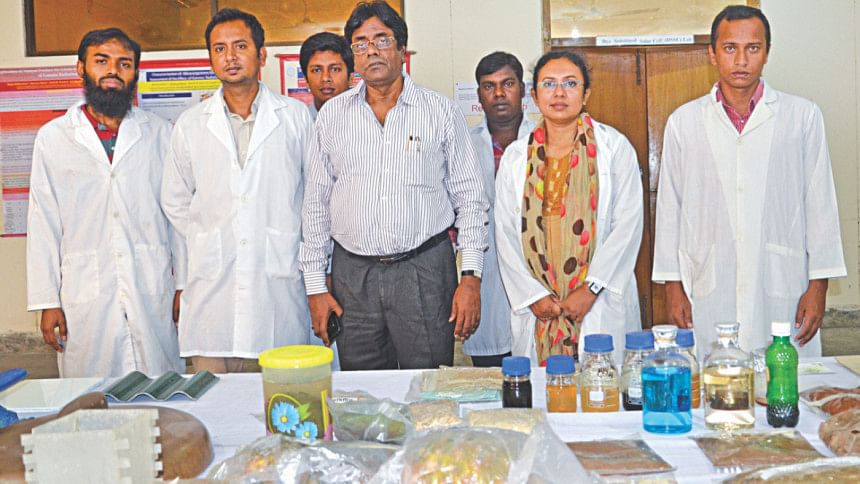Scientist creates harmless food preservative

Food preservatives have long injected fear into the collective psyche of the country's people, particularly after the widespread use of formalin creating serious health hazards. But a scientist has found the long sought-after solution -- a harmless preservative.
The preservative called "chitosan" can be used in fruits, vegetables, and fish, and it does change the taste and quality of the food, said Dr Mubarak Ahmad Khan, chief scientific officer of Bangladesh Atomic Energy Commission (BAEC), who developed the preservative.
Chitosan is derived from the hard outer skeleton of the shellfish like crab and shrimp.
Dr Mubarak said that as many traders of the country used harmful preservatives in fruits, vegetables, and fish, chitosan could ensure safe food by replacing formalin. But chitosan is costly in other countries, he said. “But this chitosan is cheap.”
One kilogramme of chitosan costs even Tk 5 lakh in some countries, while in India the price could be Tk 1 lakh, he said, adding that they were using the cheapest way to produce it. Each kilogramme would cost around Tk 20,000 here, he said.
Giving the details of its benefits, Dr Mubarak said 1kg of mangoes could be treated by only Tk 1 worth of chitosan, and 1kg of chitosan could be achieved from 6kg of shrimp shell.
“We will be able to produce chitosan in a cheaper way… because of availability of shrimp shell in our country and the method we invented to produce chitosan,” he said.
While in other countries chitosan is made through the costly chemical method, they used the radiation method, which is cheap, he said.
On an experimental basis, chitosan was used on a one-acre pineapple field in Tangail's Madhupur at the start of cultivation last year, producing good results, said Dr Mubarak.
A huge demand of chitosan was created in the area afterwards, he said, adding that they would provide chitosan to the farmers of the area free this year.
Chitosan makes pesticide unnecessary, he said. Dr Mubarak said the horticulture department in Chapainawabganj used chitosan on mangoes and got good results.
Chitosan can also be used in fish.
Fish starts to rot after three to four hours normally, but chitosan could extend it to 21 hours; in the refrigerator, the preservation period would be 20 to 25 days, he said. Dr Mubarak said though there was a huge demand for chitosan, they could not supply it due to a lack of investment involving the cost of a pilot scale production -- before commercial production -- and the product's marketing.
Around Tk 10 crore will be needed for these, he said, but private investors did not show interest in the big investment considering risks.
The government gave them support for the initial work but they did not get money for a pilot scale production, which is very necessary, he said.
The scientist, however, said Bangladesh Chemical Industries Corporation (BCIC) once declared that they would produce chitosan commercially, and they selected three possible places to provide land for this -- Barokundo Chemical Industry in Chittagong, Nayarhat BCIC Leather Complex, and ceramic industry area in Dhaka.
If they get land, the cost would fall to Tk 5 to 6 crore, he added.
Dr Mubarak said the governance innovation unit of the Prime Minister's Office (PMO) had provided Tk 4 lakh initially in 2013, and with the money they campaigned and experimented on fruits. Another Tk 3 lakh was given the next year to continue the work, he added.
But this year, the PMO gave Tk 22.5 lakh for the work, he said.
A research coordinator of BAEC, Jahid Md Mahabub Islam, said normally tomatoes and mangoes rotted within five to seven days and three to four days respectively, but chitosan could preserve tomatoes for 21 days and mangoes for eight to ten days.
Abdul Mannan, general secretary of Idilpur Anaros Chashi Bahumukhi Samobay Samity of Madhupur, who gave the one acre land for the experiment of pineapple cultivation using chitosan, said he got very good results and produced delicious pineapples.
Using chitosan, they could preserve the pineapple for 15 to 20 days, while the usual time was eight to ten days, he said.
Mannan said that to get the benefits of chitosan, a huge scale production was necessary.
He also said the use of chitosan raised the pineapple production in the one acre land by 10 percent because it saved the plant from cancer and fungi.
Sakila Jesmin, who did her PhD research in this area, said thousands of tonnes of vegetables and fruits went to waste annually in the country due to lack of sufficient technologies and knowledge on post-harvest handling, packaging, storage, and transportation. Cramming such goods into overloaded vehicles is one reason behind the drop in their freshness, she said.
According to the Bangladesh Bureau of Statistics (BBS) report, post-harvest losses among 12 fruits and vegetables ranged from the lowest 8.1 percent (litchi) to highest 32.4 percent (jackfruit) in 2010-11. The second highest loss was in banana (30.8 percent) followed by tomato (27.64 percent), cabbage (24.44 percent), and country bean (24.29 percent), Sakila said, quoting the report.
This food spoilage forced the cultivators and traders to use preservatives, but there is no safe, cheap and effective food preservative in the local market, she said.

 For all latest news, follow The Daily Star's Google News channel.
For all latest news, follow The Daily Star's Google News channel. 



Comments